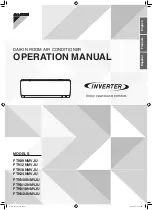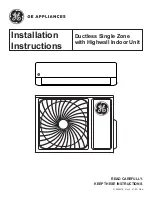
1
1
1-11-2-2-16
1
1
e
l
b
i
s
s
i
m
r
e
p
e
h
t
d
e
e
c
x
e
t
o
n
l
li
w
s
i
h
t
t
a
h
t
g
n
ir
u
s
n
e
t
u
o
h
ti
w
t
i
u
c
ri
c
e
h
t
o
t
s
d
a
o
l
e
c
n
a
ti
c
a
p
a
c
r
o
e
v
it
c
u
d
n
i
t
n
e
n
a
m
r
e
p
y
n
a
y
l
p
p
a
t
o
n
o
D
voltage and current permitted for the equipment in use.
Intrinsically safe components are the only types that can be worked on while live in the presence of a
fl
ammable atmosphere.
The test apparatus shall be at the correct rating.
f
o
n
o
it
i
n
g
i
tl
u
s
e
r
y
a
m
r
e
r
u
t
c
a
f
u
n
a
m
y
b
s
tr
a
p
d
e
fi
i
c
e
p
s
n
U
.
r
e
r
u
t
c
a
f
u
n
a
m
e
h
t
y
b
d
e
fi
i
c
e
p
s
s
tr
a
p
h
ti
w
y
l
n
o
s
t
n
e
n
o
p
m
o
c
e
c
a
l
p
e
R
refrigerant in the atmosphere from a leak.
REMOVAL AND EVACUATION
CAUTION
.
d
e
s
u
e
b
l
l
a
h
s
s
e
r
u
d
e
c
o
r
p
l
a
n
o
it
n
e
v
n
o
c
–
e
s
o
p
r
u
p
r
e
h
t
o
y
n
a
r
o
f
r
o
–
s
ri
a
p
e
r
e
k
a
m
o
t
ti
u
c
ri
c
t
n
a
r
e
g
ir
f
e
r
e
h
t
o
t
n
i
g
n
i
k
a
e
r
b
n
e
h
W
However, it is important that best practice is followed since
fl
ammability is a consideration.
The following procedure shall be adhered to:
•
.t
n
a
r
e
g
ir
f
e
r
e
v
o
m
e
R
•
Purge the circuit with inert gas.
•
Evacuate.
•
Purge again with inert gas.
•
Open the circuit by cutting or brazing.
.
s
r
e
d
n
il
y
c
y
r
e
v
o
c
e
r
t
c
e
r
r
o
c
e
h
t
o
t
n
i
d
e
r
e
v
o
c
e
r
e
b
l
l
a
h
s
e
g
r
a
h
c
t
n
a
r
e
g
ir
f
e
r
e
h
T
.
e
f
a
s
t
i
n
u
e
h
t
r
e
d
n
e
r
o
t
)
N
F
O
(
n
e
g
o
rt
i
n
e
e
rf
n
e
g
y
x
O
h
ti
w
”
d
e
h
s
u
fl
“
e
b
l
l
a
h
s
m
e
t
s
y
s
e
h
T
.
s
e
m
it
l
a
r
e
v
e
s
d
e
t
a
e
p
e
r
e
b
o
t
d
e
e
n
y
a
m
s
s
e
c
o
r
p
s
i
h
T
.
k
s
a
t
s
i
h
t
r
o
f
d
e
s
u
e
b
t
o
n
l
l
a
h
s
n
e
g
y
x
o
r
o
r
i
a
d
e
s
s
e
r
p
m
o
C
e
h
t
li
t
n
u
l
l
fi
o
t
g
n
i
u
n
it
n
o
c
d
n
a
)
N
F
O
(
n
e
g
o
rt
i
n
e
e
rf
n
e
g
y
x
O
h
ti
w
m
e
t
s
y
s
e
h
t
n
i
m
u
u
c
a
v
e
h
t
g
n
i
k
a
e
r
b
y
b
d
e
v
e
i
h
c
a
e
b
l
l
a
h
s
g
n
i
h
s
u
l
F
working pressure is achieved, then venting to atmosphere, and
fi
nally pulling down to a vacuum.
.
m
e
t
s
y
s
e
h
t
n
i
h
ti
w
s
i
t
n
a
r
e
g
ir
f
e
r
o
n
l
it
n
u
d
e
t
a
e
p
e
r
e
b
l
l
a
h
s
s
s
e
c
o
r
p
s
i
h
T
e
l
b
a
n
e
o
t
e
r
u
s
s
e
r
p
c
ir
e
h
p
s
o
m
t
a
o
t
n
w
o
d
d
e
t
n
e
v
e
b
l
l
a
h
s
m
e
t
s
y
s
e
h
t
,
d
e
s
u
s
i
e
g
r
a
h
c
)
N
F
O
(
n
e
g
o
rt
i
n
e
e
rf
n
e
g
y
x
O
l
a
n
fi
e
h
t
n
e
h
W
work to take place.
.
e
c
a
l
p
e
k
a
t
o
t
e
r
a
k
r
o
w
e
p
i
p
e
h
t
n
o
s
n
o
it
a
r
e
p
o
g
n
i
z
a
r
b
f
i
l
a
ti
v
y
l
e
t
u
l
o
s
b
a
s
i
n
o
it
a
r
e
p
o
s
i
h
T
.
e
l
b
a
li
a
v
a
n
o
it
a
li
t
n
e
v
s
i
e
r
e
h
t
d
n
a
s
e
c
r
u
o
s
n
o
it
i
n
g
i
y
n
a
o
t
e
s
o
l
c
t
o
n
s
i
p
m
u
p
m
u
u
c
a
v
e
h
t
r
o
f
t
e
lt
u
o
e
h
t
t
a
h
t
e
r
u
s
n
E
CHARGING PROCEDURES
NOTE
See “
■
Outdoor Unit” under the Section 1-11. Installation Instructions.
DECOMMISSIONING
CAUTION
.
s
li
a
t
e
d
s
ti
l
l
a
d
n
a
t
n
e
m
p
i
u
q
e
e
h
t
h
ti
w
r
a
il
i
m
a
f
y
l
e
t
e
l
p
m
o
c
s
i
n
a
i
c
i
n
h
c
e
t
e
h
t
t
a
h
t
l
a
it
n
e
s
s
e
s
i
ti
,
e
r
u
d
e
c
o
r
p
s
i
h
t
t
u
o
g
n
i
y
r
r
a
c
e
r
o
f
e
B
.
y
l
e
f
a
s
d
e
r
e
v
o
c
e
r
e
r
a
s
t
n
a
r
e
g
ir
f
e
r
ll
a
t
a
h
t
e
c
it
c
a
r
p
d
o
o
g
d
e
d
n
e
m
m
o
c
e
r
s
i
tI
f
o
e
s
u
-
e
r
o
t
r
o
ir
p
d
e
ri
u
q
e
r
s
i
s
i
s
y
l
a
n
a
e
s
a
c
n
i
n
e
k
a
t
e
b
l
l
a
h
s
e
l
p
m
a
s
t
n
a
r
e
g
ir
f
e
r
d
n
a
l
i
o
n
a
,
t
u
o
d
e
ir
r
a
c
g
n
i
e
b
k
s
a
t
e
h
t
o
t
r
o
ir
P
reclaimed refrigerant.
.
d
e
c
n
e
m
m
o
c
s
i
k
s
a
t
e
h
t
e
r
o
f
e
b
e
l
b
a
li
a
v
a
s
i
r
e
w
o
p
l
a
c
ir
t
c
e
l
e
t
a
h
t
l
a
it
n
e
s
s
e
s
i
tI
a) Become familiar with the equipment and its operation.
b) Isolate system electrically.
c) Before attempting the procedure ensure that:
•
Mechanical handling equipment is available, if required, for handling refrigerant cylinders.
•
All personal protective equipment is available and being used correctly.
•
The recovery process is supervised at all times by a competent person.
•
Recovery equipment and cylinders conform to the appropriate standards.
d) Pump down refrigerant system, if possible.
e) If a vacuum is not possible, make a manifold so that refrigerant can be removed from various parts of the system.
f) Make sure that cylinder is situated on the scales before recovery takes place.
g) Start the recovery machine and operate in accordance with manufacturer’s instructions.
h) Do not over
fi
ll cylinders. (No more than 80 % volume liquid charge).
i) Do not exceed the maximum working pressure of the cylinder, even temporarily.
j) When the cylinders have been
fi
lled correctly and the process completed, make sure that the cylinders and the equipment are
removed from site promptly and all isolation valves on the equipment are closed off.
k) Recovered refrigerant shall not be charged into another refrigeration system unless it has been cleaned and checked.
.
t
n
a
r
e
g
ir
f
e
r
e
h
t
g
n
i
g
r
a
h
c
s
i
d
r
o
g
n
i
g
r
a
h
c
n
e
h
w
n
o
it
i
d
n
o
c
s
u
o
d
r
a
z
a
h
a
e
t
a
e
r
c
d
n
a
e
t
a
l
u
m
u
c
c
a
y
a
m
e
g
r
a
h
c
c
it
a
t
s
o
rt
c
e
l
E
To avoid
fi
re or explosion, dissipate static electricity during transfer by grounding and bonding containers and equipment before
charging / discharging.
RECOVERY
NOTE
See “12. Recovery” on page 1-11-1-1-6.
SM830277-00_大洋州向け R32シングル_TD&SM.indb 16
2019/02/27 11:51:12
Summary of Contents for S-160PE1R5B
Page 12: ...MEMO Xi SM830277 00_ R32 _TD SM indb 12 19 02 26 9 34 28...
Page 136: ...MEMO 2 16 SM830277 00_ R32 _TD SM indb 16 19 02 28 13 25 27...
Page 164: ...MEMO 4 22 SM830277 00_ R32 _TD SM indb 22 19 02 21 11 54 26...
Page 202: ...MEMO 5 38 SM830277 00_ R32 _TD SM indb 38 19 02 28 13 37 39...
Page 274: ...201903 SM830277 00_ R32 _TD SM indb 1 19 02 12 9 03 53...
















































